Finding the best vacuum for detailing a car can feel like navigating a maze of options. From wet/dry vacs to cordless handhelds, the market is saturated with choices. But with the right information, you can easily pinpoint the perfect vacuum to elevate your detailing game. This guide will delve into the essential features, top contenders, and everything you need to know to choose the best vacuum for your car detailing needs.
Choosing the right vacuum is crucial for any car detailer, professional or enthusiast. A quality vacuum will not only remove dirt and debris from carpets and upholstery but also reach those hard-to-access crevices that often harbor dust and crumbs. It’s an investment that will pay off in the long run, resulting in a truly pristine finish. If you’re a professional detailer looking to upgrade your toolkit, finding the right insurance is just as crucial as finding the right vacuum. Check out our guide on what insurance does a car detailer need for more information.
Professional detailers understand the importance of a thorough clean, even on brand new vehicles. For insights into why detailing a new car is beneficial, read our article: why should i detail new car.
Types of Car Detailing Vacuums
There are several types of vacuums commonly used in car detailing, each with its own set of advantages and disadvantages.
- Wet/Dry Vacuums: These versatile machines can handle both wet and dry messes, making them ideal for tackling spills, shampooing carpets, and extracting water after a deep clean. Their powerful suction and large capacity make them a favorite among professional detailers.
- Cordless Handheld Vacuums: These compact vacuums are perfect for quick cleanups and reaching tight spaces. Their portability is a major advantage, allowing for easy maneuvering around the car’s interior.
- Shop Vacs: Similar to wet/dry vacs, shop vacs offer high power and large capacity, but they are generally larger and less portable. They are best suited for heavy-duty cleaning tasks and larger vehicles.
- Canister Vacuums: While not specifically designed for car detailing, some canister vacuums with specialized attachments can be effective for cleaning car interiors. They offer good suction and maneuverability, but their capacity is often smaller than dedicated car detailing vacuums.
Key Features to Consider
When selecting a car detailing vacuum, consider the following key features:
- Suction Power: A vacuum with strong suction is essential for effectively removing dirt, dust, and pet hair from car interiors.
- Filtration: A HEPA filter is highly recommended to trap fine dust particles and allergens, ensuring a clean and healthy car environment.
- Attachments: A variety of attachments, such as crevice tools, upholstery brushes, and extension wands, will allow you to reach every nook and cranny of your car’s interior.
- Portability: If you need to move the vacuum around frequently, consider a cordless or lightweight model.
- Noise Level: Some vacuums can be quite loud, so consider a quieter model if noise is a concern.
- Durability: A durable vacuum will withstand the rigors of regular use and provide long-lasting performance.
Top Vacuum Recommendations for Car Detailing
Here are a few top-rated vacuums that consistently perform well for car detailing:
-
Ridgid WD4070: This powerful wet/dry vacuum is a popular choice for its robust performance, large capacity, and durable construction.
-
Shop-Vac 5989300: Another excellent wet/dry option, this vacuum offers powerful suction and a large tank, making it ideal for heavy-duty cleaning.
-
Dyson V11 Animal: While more expensive, this cordless vacuum offers exceptional suction and portability, making it perfect for quick cleanups and reaching tight spaces.
-
Black+Decker dustbuster CHV1410L: This affordable handheld vacuum is a great option for spot cleaning and removing pet hair.
Curious to know how dealerships detail cars? Take a look at our article: how do dealerships detail cars.
Maintaining Your Car Detailing Vacuum
Proper maintenance will extend the life of your vacuum and ensure optimal performance.
- Empty the dustbin or tank regularly.
- Clean or replace filters as needed.
- Check and clean attachments regularly.
- Store the vacuum in a dry and protected location.
Wondering if it’s worth detailing an older car? We’ve got you covered. Read our article: does it make sense to detail an older car.
 Maintaining a car detailing vacuum
Maintaining a car detailing vacuum
Conclusion
Investing in the best vacuum for detailing a car is a crucial step towards achieving a professional-level clean. By considering the factors discussed in this guide and exploring the recommended models, you can find the perfect vacuum to meet your specific needs and elevate your detailing game. Choosing the right vacuum, combined with the expertise of a skilled detailer, can make all the difference. Learn more about what a car detailer is in our informative article: what is a car detailer.
FAQ
- What type of vacuum is best for car detailing? Wet/dry vacuums are generally considered the best for car detailing due to their versatility.
- Do I need a HEPA filter for my car detailing vacuum? A HEPA filter is highly recommended for trapping fine dust and allergens.
- How often should I clean my car detailing vacuum? Regular cleaning, including emptying the dustbin and cleaning filters, is essential for optimal performance.
- What is the best vacuum for pet hair in a car? Handheld vacuums and those with specialized pet hair attachments are generally effective for removing pet hair.
- Can I use a regular household vacuum for car detailing? While possible, a dedicated car detailing vacuum with appropriate attachments will provide better results.
- How much should I spend on a car detailing vacuum? Prices range from affordable handheld models to more expensive professional-grade vacuums.
- What are some good car vacuum brands? Ridgid, Shop-Vac, and Dyson are just a few reputable brands offering car detailing vacuums.
Need assistance? Contact us via WhatsApp: +1(641)206-8880 or Email: [email protected]. Our customer service team is available 24/7.

Leave a Reply